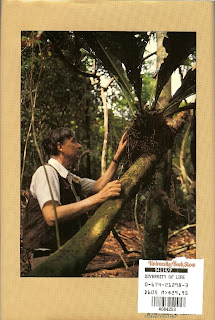
The Diversity of Life (1992) is a book by the eminent American biologist and author E. O. Wilson. If you are not into rolling up your sleeves and getting into science details or you don’t believe the earth is about 4.5 billion years old and all that goes with that, then this book is not for you. The Diversity of Life is a fascinating read that will introduce you to biodiversity, how it’s measured, and how it has changed over earth’s history.
The biodiversity of the world in its simplest definition is the number of distinct biological species. Wilson, when he wrote the book, cited about 1.4 millions species described. Today it is higher, at about 1.8 million species as given at the Encyclopedia of Life. As discussed in The Diversity of Life, the actual number of species is likely much larger by as much as a factor of ten. The current biodiversity of our planet is at its highest level ever, but is being diminished significantly by human activity. This conclusion is arrived at based on estimates of how long species lived and went extinct before humans arrived and comparing that with an estimate how many are going extinct today. For example, Wilson writes that, on average, a species lived on the order of one million years in the absence of human interference and that “human activity has increased extinction between 1,000 and 10,000 times over this level in the rain forest by reduction in area alone.” But lest you go away thinking this is another book about how bad humans are the book really doesn’t leave that impression. Rather, Wilson acknowledges how and why humans are impacting diversity and ends the book by offering five suggestions for preserving as much of earth’s diversity as possible. Without being a plot spoiler the biggest “how” is destruction of habit - see for example the IUCN Red List. The reasons “why” are more numerous and include farmers clearing rainforest to survive and feed families and general unfamiliarity with what species are at stake (the “unknown unknowns” to quote Rumsfeld), to name just two.
There are several interesting ideas that Wilson weaves into the diversity narrative that are worth pointing out:
- Why do the tropics dominate in biodiversity? Because there is more solar energy available, the climate is more constant, and there are large areas available for life. These three factors are described by Wilson as the Energy-Stability-Area (ESA) Theory of Biodiversity.
- How many extinction events were there? There were five great extinctions when diversity plummeted dramatically including the Ordovician (440 million years ago), Devonian (365 mya), Permian (245 mya), Triassic (210 mya) and Cretaceous (66 mya) extinctions. The last extinction took out the dinosaurs.
- Why is biodiversity so high now? According to Wilson, it is due to widely separated continents with long shorelines and stretches of shallow tropical waters with islands. It wasn’t always like that.
- What is the smallest number of breeding individuals of a species that are considered healthy for that species? Risk of extinction of a species is given approximately by the 50/500 rule. 50 healthy adults are the minimum needed to avoid inbreeding, and 500 for long term viability.
- Species that have evolved to specialized environments are in general more vulnerable to extinction than less specialized species.
- The richest nations (mostly northern) preside over the smallest and least interesting biota and conversely, the poorest nations preside over the largest and most diverse biota.
- Human diets are narrow by choice, not by natural mandate. Our reliance on a fixed number of plants and animals has negative diversity consequences because land cleared to grow these plants and animals can often be utilized more efficiently growing different, often locally tailored choices.
- Exemptionalism is the belief that humans are a new order of life and are exempt from environmental forces. Wilson urges that we be on guard and that we do not fall prey to exemptionalism by letting species perish and biodiversity decline.
One aspect of the book that is especially nice is the use of ample diagrams, illustrations, and photos interspersed throughout. These, taken with Wilson’s writing style make this an accessible book for a wide range of readers. One hint for reading The Diversity of Life is to check the Notes section for each chapter while reading the chapter. There is valuable information contained in the notes that will help you understand how Wilson reached his conclusions.
In Chapter 14, Resolution, Wilson details five recommendations for preserving the earth’s diversity. The recommendations are aimed not at the reader so much as at society and government. The last chapter (15), The Environmental Ethic, in contrast is aimed at the reader, challenging the reader to acknowledge phobias, any exemptionalist ideas we might have, and ideas that the world is completely explored and we know everything there is to know about it. Still, there are fundamental challenges to having this enlightened “environmental ethic” be widespread, especially when it’s advice coming from one of those biota-challenged rich nations. Wilson writes earlier in the book:
What counts is food today, a healthy family, and tribute for the chief, victory celebrations, rites of passage, feasts. As the Mexican truck driver said who shot one of the last two imperial woodpeckers, largest of all woodpeckers, ‘It was a great piece of meat.’

No comments:
Post a Comment
All comments are moderated. If your comment doesn't appear right away, it was likely accepted. Check back in a day if you asked a question.